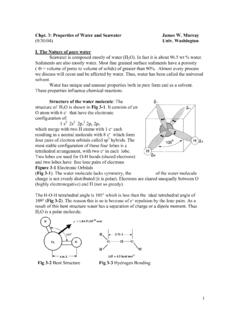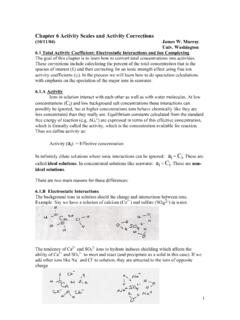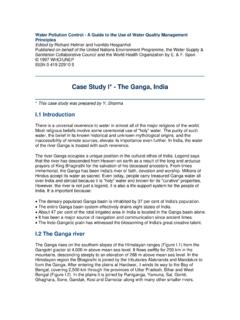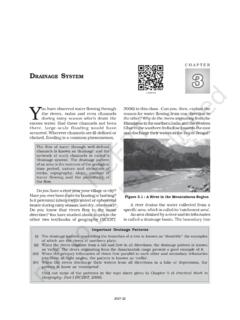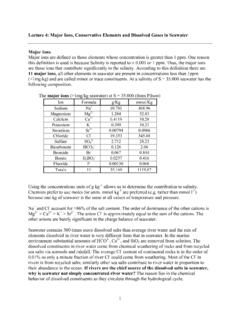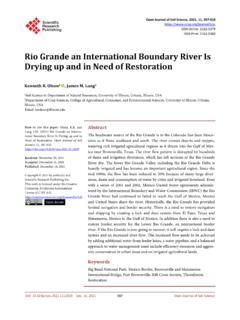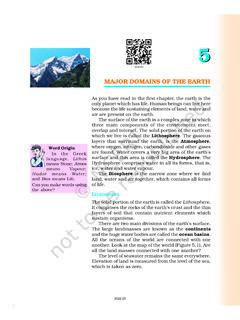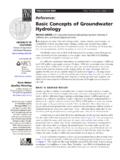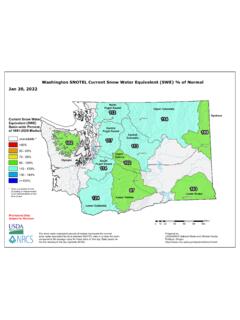Transcription of Chpt 4: Major Ions of Seawater James Murray (10/01/04 ...
1 1 Chpt 4: Major Ions of Seawater James Murray (10/01/04) Univ. Washington Major Ions Major ions are defined as those elements whose Seawater concentration is greater than 1 ppm. The main reason this definition is used is because salinity is reported to or 1 ppm. Thus, the Major ions are those ions that contribute significantly to the salinity. According to this definition there are 11 Major ions. At a salinity of S = Seawater has the composition given in Table 4-1 (from Pilson, 1998). The data in this table mainly come from a set of complete Major ion analyses conducted at the University of Liverpool in the early 1960s on a representative set of over 100 Seawater samples (Cox and Culkin, 1966; Morris and Riley, 1966; Riley and Tongudai, 1967).
2 Such a Major effort will probably never be undertaken again baring some Major breakthroughs in analytical chemistry. Using the concentrations units of g kg-1 allows us to determine the contribution to Table 4-1 Concentrations of the Major Ions (from Pilson, 1998, Chpt. 4) 2salinity. Chemists prefer to use moles for units, thus mmol kg-1 are preferred ( rather than mmol l-1). Also mmol kg-1 is preferred over mmol l-1 (or mM) because one kg of Seawater is the same at all values of T and P, wheras the mass in one liter can vary. Seawater is first of all a solution of NaCl. Na and Cl account for greater then 86% of the salt content by mass.
3 The order of the other cations is Mg2+ > Ca2+ > K+ > Sr2+. The anion Cl- is approximately equal to the sum of the cations. The other anions (SO42-, HCO3-, Br-, F-) are much less significant in the charge balance of Seawater . An element is conservative in Seawater if its ratio to salinity is constant in different parts of the ocean. The ratio of one conservative element to another will also be constant. One way to establish if an element of unknown reactivity is conservative is to plot it versus another conservative element or conservative property like potential temperature or salinity. This is referred to as The Law of Constant Proportions.
4 Conservative elements are conservative because they have very low chemical reactivity and their distributions in the ocean interior are determined only by currents and mixing. The list of elements considered conservative has changed over time as analytical techniques have improved. The Law of Constant proportions breaks down some places where water sources have different ionic ratios or where extensive chemical reactions modify the composition. Examples are: 1. estuaries: The average composition of river water is given in Table 4-2 (from Langmuir, 1997). The concentrations are given in mg l-1 and can be compared with Seawater concentrations.
5 The main difference is that HCO3- is the main anion in river water and has a much higher concentration than Cl- (which is the lowest of the Major anions in river water). Calcium is the main cation in river water, followed by Na and Mg, then K. 2. evaporitic brines form in isolated Seawater embayments where various solids precipitate, thus changing the relative concentrations left in solution. 3. anoxic waters in restricted marine basins and pore (interstitial) waters in sediments where dissolution/precipitation and oxidation/reduction reactions can change the relative composition (especially of SO42-). 4.
6 Hydrothermal vents (Table 4-3 from Von Damm et al, 1985). These high-temperature waters differ from Seawater in that Mg, SO4 and alkalinity have all been quantitatively removed. 3 Specific Examples a) Na, K, SO4, Br, B and F have constant ratios to Cl and each other, everywhere in the ocean. These elements are conservative. There are reasons to think that SO4 may be non-conservative in anoxic marine basins like the Black Sea but conclusive results showing nonconservative distributions have not been observed. Sulfate depletions are frequently seen in pore water due to sulfate reduction. Boron is partly present in Seawater as the neutral species (B(OH)3 ) and it has been hypothesized that B may be distilled from surface water in the tropics during evaporation and transported to high latitudes through the atmosphere.
7 Rain is enriched in B (Martens and Harriss, 1976) but non-conservative distributions in the ocean have not been identified. Table 4-2 river water versus Seawater (from Langmuir, 1997) mM 4 Table 4-3 Composition of Hydrothermal vent solutions. Four high temperature (~350 C) sites from 21 N on the East Pacific Rise (NGS, OBS, North, HG) and the average value from the low temperature Galapagos Spreading Center (GSC). Concentrations in mmol kg-1. From Von Damm et al, 1985). 5b) Ca has small (+ ) but systematic variations within the ocean. This has been known since the earliest analyses of Seawater .
8 Dittmar (1884) used precise analyses of 77 Challenger samples to show that the calcium/chloride ratio was higher in deep water then in surface waters. When the Ca increase was first discovered by Dittmar it was hypothesized to be due to dissolution of CaCO3 particles. Brewer et al. (1975) showed that the change in alkalinity with depth in the ocean (where Alkalinity HCO3- + 2 CO32-) was less than that expected for the change in Ca. Actually according to the CaCO3 solubility reaction ( CaCO3(s) = Ca2+ + CO32-), the changes should follow the expression Alkalinity = 2 Ca. Calcium increases by 100-130 M as deep water flows from the Atlantic to the Pacific (Fig.)
9 4-1) but alkalinity only increases by 120-130 M. As the calcium data are probably sound, Brewer et al.(1975) suggested that this was because the alkalinity was low due to titration by HNO3 produced by respiration of organic matter in the deep sea. The correct comparison should be of Ca with potential alkalinity which is the total alkalinity corrected for the NO3 produced according to: Potential Alkalinity = Alkalinity + NO3- The increase in NO3 from the deep Atlantic to Pacific is about 30 M, which should decrease alkalinity by the same amount. This is an important correction to make but there is still a "calcium problem".
10 New data from de Villiers (personal communication) shows that Ca increases systematically from the surface to the deep water and from the North Atlantic to North Pacific (Fig 4-1). CaCO3 dissolution may not be the only source of disolved Ca. DeVilliers showed that variations in Ca and potential alkalinity were in good agreement from 0-1000 m and in the deep water (>3500 m), but that there was additional excess Ca in the mid-water column centered at about 2000 to 2500 m (Fig. 4-2). She argued that this was primarily due to diffuse source low-temperature hydrothermal input from mid-ocean ridges. For support the xsCa correlates well with other hydrothermal tracers like 3He and Si (Fig.)



